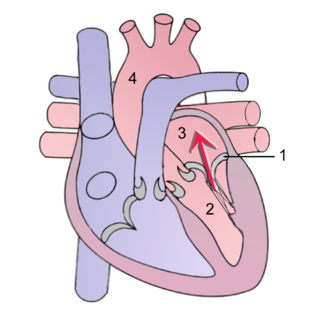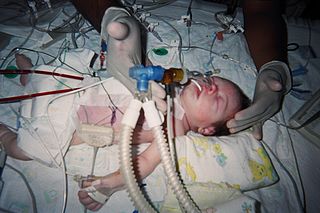
Cardiothoracic surgery is the field of medicine involved in surgical treatment of organs inside the thoracic cavity — generally treatment of conditions of the heart, lungs, and other pleural or mediastinal structures.

Aortic regurgitation (AR), also known as aortic insufficiency (AI), is the leaking of the aortic valve of the heart that causes blood to flow in the reverse direction during ventricular diastole, from the aorta into the left ventricle. As a consequence, the cardiac muscle is forced to work harder than normal.

Interventional cardiology is a branch of cardiology that deals specifically with the catheter based treatment of structural heart diseases. Andreas Gruentzig is considered the father of interventional cardiology after the development of angioplasty by interventional radiologist Charles Dotter.

Cardiac surgery, or cardiovascular surgery, is surgery on the heart or great vessels performed by cardiac surgeons. It is often used to treat complications of ischemic heart disease ; to correct congenital heart disease; or to treat valvular heart disease from various causes, including endocarditis, rheumatic heart disease, and atherosclerosis. It also includes heart transplantation.

Mitral regurgitation(MR), also known as mitral insufficiency or mitral incompetence, is a form of valvular heart disease in which the mitral valve is insufficient and does not close properly when the heart pumps out blood. It is the abnormal leaking of blood backwards – regurgitation from the left ventricle, through the mitral valve, into the left atrium, when the left ventricle contracts. Mitral regurgitation is the most common form of valvular heart disease.
Aortic valve replacement is a procedure whereby the failing aortic valve of a patient's heart is replaced with an artificial heart valve. The aortic valve may need to be replaced because:
In medical and surgical therapy, revascularization is the restoration of perfusion to a body part or organ that has had ischemia. It is typically accomplished by surgical means. Vascular bypass and angioplasty are the two primary means of revascularization.

Mitral valve repair is a cardiac surgery procedure performed by cardiac surgeons to treat stenosis (narrowing) or regurgitation (leakage) of the mitral valve. The mitral valve is the "inflow valve" for the left side of the heart. Blood flows from the lungs, where it picks up oxygen, through the pulmonary veins, to the left atrium of the heart. After the left atrium fills with blood, the mitral valve allows blood to flow from the left atrium into the heart's main pumping chamber called the left ventricle. It then closes to keep blood from leaking back into the left atrium or lungs when the ventricle contracts (squeezes) to push blood out to the body. It has two flaps, or leaflets, known as cusps.
The intra-aortic balloon pump (IABP) is a mechanical device that increases myocardial oxygen perfusion and indirectly increases cardiac output through afterload reduction. It consists of a cylindrical polyurethane balloon that sits in the aorta, approximately 2 centimeters (0.79 in) from the left subclavian artery. The balloon inflates and deflates via counter pulsation, meaning it actively deflates in systole and inflates in diastole. Systolic deflation decreases afterload through a vacuum effect and indirectly increases forward flow from the heart. Diastolic inflation increases blood flow to the coronary arteries via retrograde flow. These actions combine to decrease myocardial oxygen demand and increase myocardial oxygen supply.

Arterial switch operation (ASO) or arterial switch, is an open heart surgical procedure used to correct dextro-transposition of the great arteries (d-TGA).
Cardioplegia is a solution given to the heart during cardiac surgery, to minimize the damage caused by myocardial ischemia while the heart is paused.
The following outline is provided as an overview of and topical guide to cardiology, the branch of medicine dealing with disorders of the human heart. The field includes medical diagnosis and treatment of congenital heart defects, coronary artery disease, heart failure, valvular heart disease and electrophysiology. Physicians who specialize in cardiology are called cardiologists.
David H. Adams is an American cardiac surgeon and the Marie-Josée and Henry R. Kravis Professor and Chairman of the Department of Cardiothoracic Surgery, Icahn School of Medicine at Mount Sinai Hospital in New York City. Dr. Adams is a recognized leader in the field of heart valve surgery and mitral valve reconstruction. As director of Mount Sinai Mitral Valve Repair Center, he has set national benchmarks with >99% degenerative mitral valve repair rates, while running one of the largest valve repair programs in the United States. Dr. Adams is the co-inventor of 2 mitral valve annuloplasty repair rings – the Carpentier-McCarthy-Adams IMR ETlogix Ring and the Carpentier-Edwards Physio II Annuloplasty Ring, and is a senior consultant with royalty agreements with Edwards Lifesciences. He is also the inventor of the Tri-Ad Adams Tricuspid Annuloplasty ring with a royalty agreement with Medtronic. He is a co-author with Professor Alain Carpentier of the benchmark textbook in mitral valve surgery Carpentier's Reconstructive Valve Surgery. He is also the National Co-Principal Investigator of the FDA pivotal trial of the Medtronic-CoreValve transcatheter aortic valve replacement device.
Cardiothoracic anesthesiology is a subspeciality of the medical practice of anesthesiology, devoted to the preoperative, intraoperative, and postoperative care of adult and pediatric patients undergoing cardiothoracic surgery and related invasive procedures.
Minimally invasive cardiac surgery, also known as MICS CABG or the McGinn technique is heart surgery performed through several small incisions instead of the traditional open-heart surgery that requires a median sternotomy approach. MICS CABG is a beating-heart multi-vessel procedure performed under direct vision through an anterolateral mini-thoracotomy.
Endoscopic vessel harvesting (EVH) is a surgical technique that may be used in conjunction with coronary artery bypass surgery. For patients with coronary artery disease, a physician may recommend a bypass to reroute blood around blocked arteries to restore and improve blood flow and oxygen to the heart. To create the bypass graft, a surgeon will remove or "harvest" healthy blood vessels from another part of the body, often from the patient's leg or arm. This vessel becomes a graft, with one end attaching to a blood source above and the other end below the blocked area, creating a "conduit" channel or new blood flow connection across the heart.

MitraClip is a medical device used to treat mitral valve regurgitation for individuals who should not have open-heart surgery. It is implanted via a tri-axial transcatheter technique and involves suturing together the anterior and posterior mitral valve leaflets.
Dr R Ravi Kumar graduated from Stanley Medical College and obtained the FRCS from Edinburgh. He worked at the Harefield Hospital, UK, under Sir Magdi Yacoub involving himself with adult cardiac surgery including heart and lung transplant and aortic homografts. Dr Ravi Kumar then underwent surgical residency in Boston, MA, United States. Following this he worked with Dr Albert Starr in Portland, Oregon. He pursued his cardiothoracic residency at the University of Texas, South Western Medical Center, Dallas, Texas, U.S. He continued at the same institution as an advanced fellow in Heart & Lung Transplant and is UNOS, certifiable for Heart & Lung Transplant.
Eric A. Rose is an American cardiothoracic surgeon, scientist, entrepreneur and professor and Chairman of the Department of Population Health Science & Policy, and Associate Director for Clinical Outcomes at Mount Sinai Heart. He is best known for performing the first successful paediatric heart transplant, in 1984 while at NewYork–Presbyterian Hospital (NYP).
John D. Puskas is an American researcher, author, inventor and cardiovascular surgeon. As of 2022, he is Professor, Cardiovascular Surgery, Icahn School of Medicine at Mount Sinai, and chairman, Department of Cardiovascular Surgery at Mount Sinai Morningside, Mount Sinai Beth Israel and Mount Sinai West. He holds 11 U.S. patents and co-founded the International Coronary Congress and the International Society for Coronary Artery Surgery. He is credited by ResearchGate with 330 publications and 15,234 citations and as of 2022 Scopus reports an h-index of 62. Puskas is known for advancing coronary artery bypass (CABG) surgery by refining surgical techniques for all-arterial, off-pump CABG and inventing finer instruments to be used for advanced coronary bypass surgical procedures. He is credited with performing the first totally thoracoscopic bilateral pulmonary vein isolation procedure. He is the co-editor of State of the Art Surgical Coronary Revascularization, the first textbook solely devoted to coronary artery surgery.







